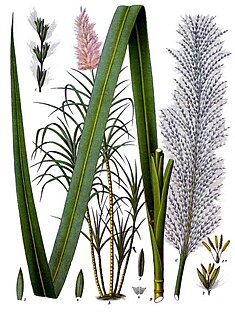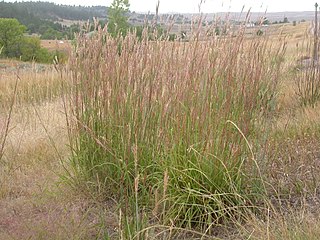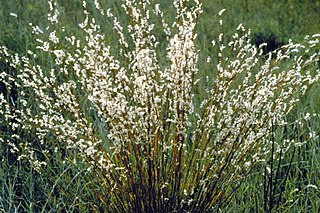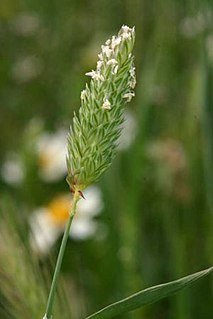
Saccharum is a genus of tall perennial plants of the broomsedge tribe within the grass family.

Forage is a plant material eaten by grazing livestock. Historically, the term forage has meant only plants eaten by the animals directly as pasture, crop residue, or immature cereal crops, but it is also used more loosely to include similar plants cut for fodder and carried to the animals, especially as hay or silage.

Andropogon gerardi, commonly known as big bluestem, is a species of tall grass native to much of the Great Plains and grassland regions of central and eastern North America. It is also known as tall bluestem, bluejoint, and turkeyfoot.

Digitaria is a genus of plants in the grass family native to tropical and warm temperate regions but can occur in tropical, subtropical, and cooler temperate regions as well. Common names include crabgrass, finger-grass, and fonio. They are slender monocotyledonous annual and perennial lawn, pasture, and forage plants; some are often considered lawn pests. Digitus is the Latin word for "finger", and they are distinguished by the long, finger-like inflorescences they produce.

Schizachyrium scoparium, commonly known as little bluestem or beard grass, is a species of North American prairie grass native to most of the contiguous United States as well as a small area north of the Canada–US border and northern Mexico. It is most common in the Midwestern prairies and is one of the most abundant native plants in Texas grasslands.

Andropogon is a widespread genus of plants in the grass family, native to much of Asia, Africa, and the Americas, as well as southern Europe and various oceanic islands.

Bothriochloa is a common and widespread genus of plants in the grass family native to many countries on all inhabited continents and many islands. They are often called beardgrass, bluegrass or bluestem.

Eulalia is a genus of Asian, African, and Australian plants in the grass family.

Phalaris minor is a species of grass native to North Africa, Europe, and South Asia. The bunchgrass is widely naturalised elsewhere.

Schizachyrium is a widespread genus of plants in the grass family. The name is derived from the Ancient Greek words σχίζειν, meaning "to split," and ἄχυρον, meaning "chaff." It refers to either the glume or the toothed lemmas.
Desmostachya is a genus of grass in the family Poaceae.

Dichanthium, known commonly as bluestem or bluegrass, is a genus of African, Asian, and Australian plants in the grass family.

Trema orientale is a species of flowering tree in the hemp family, Cannabaceae. It is known by many common names, including charcoal-tree, Indian charcoal-tree, pigeon wood, Oriental trema, and in Hawaii, where it has become naturalized, gunpowder tree, or nalita. It has a near universal distribution in tropical and warm temperate parts of the Old World, with a range extending from South Africa, through the Middle East, the Indian subcontinent and southern China to Southeast Asia and Australia.
Jensenia spinosa is a dioicous bryophyte plant in the liverwort family Pallaviciniaceae. It is the only African member of the genus Jensenia, and generally occurs at high elevations. It is widespread but scarce, and has been found in South Africa, Malawi, Tanzania, Rwanda, the Democratic Republic of the Congo, as well as the islands of Mauritius, Réunion and Saint Helena.
Charles Edward Hubbard was a British botanist, specialising in agrostology – the study of grasses. He was considered "the world authority on the classification and recognition of grasses" in his time.

Boophone disticha is a bulbous tropical and subtropical flowering plant, endemic to Africa. Commonly called the century plant or tumbleweed, Boophone disticha was first collected in 1781 from South Africa by Swedish botanist Carl Peter Thunberg and described by Carl Linnaeus as Amaryllis disticha. Since that time it has been placed in the genera Brunsvigia and Haemanthus, finally coming to rest as Boophone. The genus itself was written in three ways by the author William Herbert, straining the procedures of the rules of nomenclature. The etymology of the genus is from the Greek bous = ox, and phontes= killer of, a clear warning that eating the plant can be fatal to livestock.
Andropogon capillipes is a species of grass known by the common name chalky bluestem. It is native to the southeastern United States as far west as Texas.

Poa poiformis, commonly known as coast tussock-grass or blue tussock-grass, is a densely tufted, erect, perennial tussock grass, with distinctive blue-green leaves, that grows to about 1 m in height. Its inflorescences are arranged in a dense panicle up to 30 cm long. It is native to coastal southern Australia where it occurs along ocean foreshores, estuaries, dunes and cliffs. P. poiformis is also found on Kangaroo Island and Lord Howe Island.

Bothriochloa pertusa is a species of grass. It is widely used as a fodder and a graze for livestock.
Claviceps pusilla, also known as bluestem ergot, is a parasitic fungus primarily of the grass tribe Angropogoneae, particularly those in the tribe referred to as "bluestem". C. pusilla occasionally manifests characteristic triangular conidia which appear to be unique among Claviceps species.















